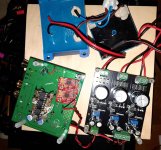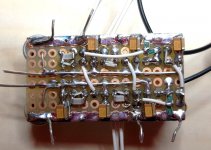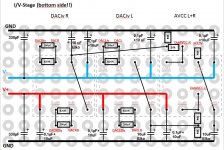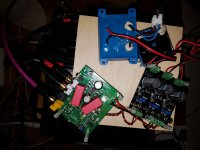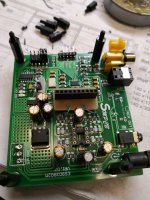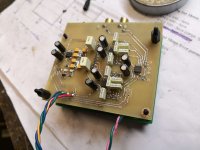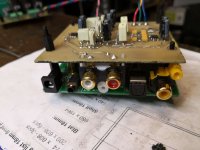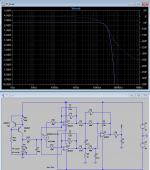Hi Mike,
Nice to see you are making progress.
Although not currently a pressing need here, I would be interested to try out some super regulators some time, and I see the boards are coming back into to stock at the diyaudio store. There is a discount on pre-orders that might be worth considering if anyone else is interested.
As far as AVCC goes, for the ES9038Q2M modding project the opamp circuit we are using seems to work fine. It just won't work for PRO chips because of the higher current requirements. That is one of the reasons I decided to stick with Q2M for this project. There are enough puzzles to work on without adding more. I still think the main advantage, or potential advantage of PRO chips (for stereo use) is lower noise. But, Q2M noise is still pretty good, rated by ESS at -122dB. (PRO also may be able to do a bit more with interpolation filtering with some register tweaking, but few designs seem to take advantage of it.)
Mike, um, if you have been reading along with our progress here, have you started giving any thought to working on register tweaking? Eventually, you may have to do it if you want sound quality as good as we can get with Q2M. Only way around that might be if your existing dac firmware gives you access to DPLL and distortion compensation adjustments.
Nice to see you are making progress.
Although not currently a pressing need here, I would be interested to try out some super regulators some time, and I see the boards are coming back into to stock at the diyaudio store. There is a discount on pre-orders that might be worth considering if anyone else is interested.
As far as AVCC goes, for the ES9038Q2M modding project the opamp circuit we are using seems to work fine. It just won't work for PRO chips because of the higher current requirements. That is one of the reasons I decided to stick with Q2M for this project. There are enough puzzles to work on without adding more. I still think the main advantage, or potential advantage of PRO chips (for stereo use) is lower noise. But, Q2M noise is still pretty good, rated by ESS at -122dB. (PRO also may be able to do a bit more with interpolation filtering with some register tweaking, but few designs seem to take advantage of it.)
Mike, um, if you have been reading along with our progress here, have you started giving any thought to working on register tweaking? Eventually, you may have to do it if you want sound quality as good as we can get with Q2M. Only way around that might be if your existing dac firmware gives you access to DPLL and distortion compensation adjustments.
Well it has already been nearly a year now since I started thinking about DACs. The road has been generally good with some bumps along the way when I let out some smoke in the Q2M. The next stage is going to be packing it into a case and enjoying it.
What is really interesting is that even with low bit rate MP3s, the sound is markedly improved and quite listenable to boot. The reason I say that is because, obviously there are things in many DAC circuits that are not being done right and we appear to be very sensitive to it, but not necessarily measurable at this time.
I am now convinced that lower noise on the AVCC line is not the real target but the dynamic aspect of what happens on the line is key. Otherwise LT3042s would have been excellent but they clearly are not in real terms.
I'm kind of upset at myself because I had these Sulzer boards just sitting there all the while ready to be used with a couple changes and I kept thinking I needed an op amp that ran on lower rails like the Jung Super Regulators.
In the New Year, I will put in a Super Regs on the AVCC line and see where that goes. Also remember that I have not even installed the voltage sense lines remotely on the DAC as yet. The kelvin sense lines are one of the bigger point of the Super Regulators and in my situation where the supplies are off board, it mitigates the problem of wire runs to the DAC.
I expect when I install all the sense lines, the sound should improve even more.
What I look for in music is not necessarily the lowest distortion but the imaging, detail and dynamics both large and micro. I think my brain adjusts to some distortion over time as long as it is not too much. Register tweaking...not sure...but then again I intially thought your project of taking the q2m apart was undoable months ago.
Interesting how that these Super Regs started life as Sulzers in 1980 and I am using boards I made in the mid 80s today! Talk about progress.
What is really interesting is that even with low bit rate MP3s, the sound is markedly improved and quite listenable to boot. The reason I say that is because, obviously there are things in many DAC circuits that are not being done right and we appear to be very sensitive to it, but not necessarily measurable at this time.
I am now convinced that lower noise on the AVCC line is not the real target but the dynamic aspect of what happens on the line is key. Otherwise LT3042s would have been excellent but they clearly are not in real terms.
I'm kind of upset at myself because I had these Sulzer boards just sitting there all the while ready to be used with a couple changes and I kept thinking I needed an op amp that ran on lower rails like the Jung Super Regulators.
In the New Year, I will put in a Super Regs on the AVCC line and see where that goes. Also remember that I have not even installed the voltage sense lines remotely on the DAC as yet. The kelvin sense lines are one of the bigger point of the Super Regulators and in my situation where the supplies are off board, it mitigates the problem of wire runs to the DAC.
I expect when I install all the sense lines, the sound should improve even more.
What I look for in music is not necessarily the lowest distortion but the imaging, detail and dynamics both large and micro. I think my brain adjusts to some distortion over time as long as it is not too much. Register tweaking...not sure...but then again I intially thought your project of taking the q2m apart was undoable months ago.
Interesting how that these Super Regs started life as Sulzers in 1980 and I am using boards I made in the mid 80s today! Talk about progress.
Last edited:
Is the AD4898 specified for use on single rail voltages? I have checked and see neither any mention nor specification when and if used with single rails.
Almost any opamps can be used with single rail supply, it depends on PS headroom on
both IP and OP stage. The ADA does not have rail to rail OP swing like a lot
of the newer Texas opamps so that may be a factor.
Are you considering using it for AVCC?
T
Well it has already been nearly a year now since I started thinking about DACs. The road has been generally good with some bumps along the way when I let out some smoke in the Q2M. The next stage is going to be packing it into a case and enjoying it.
What is really interesting is that even with low bit rate MP3s, the sound is markedly improved and quite listenable to boot. The reason I say that is because, obviously there are things in many DAC circuits that are not being done right and we appear to be very sensitive to it, but not necessarily measurable at this time.
I am now convinced that lower noise on the AVCC line is not the real target but the dynamic aspect of what happens on the line is key. Otherwise LT3042s would have been excellent but they clearly are not in real terms.
I'm kind of upset at myself because I had these Sulzer boards just sitting there all the while ready to be used with a couple changes and I kept thinking I needed an op amp that ran on lower rails like the Jung Super Regulators.
In the New Year, I will put in a Super Regs on the AVCC line and see where that goes. Also remember that I have not even installed the voltage sense lines remotely on the DAC as yet. The kelvin sense lines are one of the bigger point of the Super Regulators and in my situation where the supplies are off board, it mitigates the problem of wire runs to the DAC.
I expect when I install all the sense lines, the sound should improve even more.
What I look for in music is not necessarily the lowest distortion but the imaging, detail and dynamics both large and micro. I think my brain adjusts to some distortion over time as long as it is not too much. Register tweaking...not sure...but then again I intially thought your project of taking the q2m apart was undoable months ago.
Interesting how that these Super Regs started life as Sulzers in 1980 and I am using boards I made in the mid 80s today! Talk about progress.
Mike, if you want the 'stiffest' transformer, then it's worth looking at
possibility of different transformer designs. The VA rating is purely based on
the transformers ability to deliver a certain amount of current with a certain
amount of temperature rise. The VA rating does not really tell you that much
about it's OP impedance or ability to deliver short term current transients.
This is called the regulation. So for say a 10% regulation spec, at full VA, the OP voltage will collapse (reduce) by 10%.
Generally speaking smaller VA transformers have much worse regulation, even beyond the scaling of their VA, so they can be very 'spongy'.
WRT different transformer designs, Toroids generally have the worse regulation. The best are 'C' core, then EI core. I'm not sure where R core fit
in the spectrum but I think they are pretty good.
Also if you get an EI or C core traffo made, you can specify a very effective electrostatic shield between P and S which can improve sound.
Lot's of options to play with 🙂
T
Almost any opamps can be used with single rail supply, it depends on PS headroom on
both IP and OP stage. The ADA does not have rail to rail OP swing like a lot
of the newer Texas opamps so that may be a factor.
Are you considering using it for AVCC?
T
Yes, that certainly is a factor as I was thinking of the possibility of AVCC running on 3.3V rail. I have some AD8031s on the way. We'll see what happens in the New Year.
No matter, as it is now. I'm thrilled to say the very very least. All recordings including some of my old favorites are NEW again.
Well, I always was told that Toroids were good since way back. But the 30VA is one of those chinese C core or R I think. It is worth noting that I went from 15VAC in the C or R core to 18VAc secondaries in the transformer swap. So in reality it was not apples to apples since the higher unregulated voltage can be a factor since the stored potential energy in the caps is significantly higher 44% higher because it is Voltage squared. Now I contribute more to global warming since I have to dissipate it in the reg. The price to pay.Mike, if you want the 'stiffest' transformer, then it's worth looking at
possibility of different transformer designs. The VA rating is purely based on
the transformers ability to deliver a certain amount of current with a certain
amount of temperature rise. The VA rating does not really tell you that much
about it's OP impedance or ability to deliver short term current transients.
This is called the regulation. So for say a 10% regulation spec, at full VA, the OP voltage will collapse (reduce) by 10%.
Generally speaking smaller VA transformers have much worse regulation, even beyond the scaling of their VA, so they can be very 'spongy'.
WRT different transformer designs, Toroids generally have the worse regulation. The best are 'C' core, then EI core. I'm not sure where R core fit
in the spectrum but I think they are pretty good.
Also if you get an EI or C core traffo made, you can specify a very effective electrostatic shield between P and S which can improve sound.
Lot's of options to play with 🙂
T
And yes, I had an extra line on the removed transformer which I assume was the electrostatic shield...this one is destined for the video dac now.
Off topic, a bit.
Incorperating the connecting wire in feedback loop - the impedance at the termination point will drop significantly.
I have use the same trick with amplifiers - third binding post - extend the feedback loop to the speaker.
...I expect when I install all the sense lines, the sound should improve even more...
Incorperating the connecting wire in feedback loop - the impedance at the termination point will drop significantly.
I have use the same trick with amplifiers - third binding post - extend the feedback loop to the speaker.
WRT different transformer designs, Toroids generally have the worse regulation.
Surely some mistake 😛 Toroids tend to have the best regulation, the 'donut' shape means less copper is needed and they can run at slightly higher flux levels as the grain of the core can be arranged to be in the right direction.
Toroids' weakness is their inter-winding capacitance is generally the greatest. Or another way to put this is their leakage inductance is lowest, making them a fairly wide-band portal to mains-borne noise. For audio I believe split-bobbin EI core transformers are best due to having lowest inter-winding capacitance, but the corollary of this is they're leaky of flux so keep them well away from sensitive circuits.
... they can run at slightly higher flux levels as the grain of the core can be arranged to be in the right direction.
One reason that torroids are often run at higher flux levels is because it is easier to do than with EI cores. The ratio of winding window area vs magnetic flux path makes means its easy to fit a lot of ampere-turns/meter in there.
SDA and SCL are I2C bus pins to communicate with dac chip registers.
RESTB is to reset the dac chip to defaults.
Most likely your output is muted because something not configured correctly for it to obtain a LOCK on the input signal. For one thing, there are three possible versions of what we commonly refer to as I2S. There is 'Left Justified,' Right Justified,' and 'Philips I2S.' if one of those things is configured inappropriately then I2S LOCK will fail. If you want to completely take over control of the dac chip, then you might be able to, but you may risk permanently breaking normal operation of the dac unless you know what you are doing.
May I ask why you are trying to use an external interface? Is the dac designed to support that?
the internal interface is broken so this is the only chance of fixing this, The BCLK, SDATA, and LRCLK traces from internal interface were cut and corresponding outputs from external interface was connected instead.
If worst comes to worst the SPDIF input on this DAC works fine and the new interface has a SPDIF output
the internal interface is broken so this is the only chance of fixing this, The BCLK, SDATA, and LRCLK traces from internal interface were cut and corresponding outputs from external interface was connected instead.
Do you have an oscilloscope to check the signals? Did you hook up ground too?
Hi all,
I did some Progress on my DAC mod. below Picture of the board plus the schematic of the i/v stage combined with the AVCC opamp stage. 3,3V reference voltage was intented to be delivered by LT6655 but is now provided by the 3,3V clock reg. as after my very bad Trial of soldering this small chip onto the breakoutboard it finally was fried I guess - at least it showed only 145mV Output yesterday before starting my listening session, so I soldered the ref line to the clock source. Here in short, what I modified in HW:
- new Clock 3,3V PSU
- new VCCA 3,3 PSU (1 for both lines)
- new SPDIF amp PSU (LP5907)
- AVCC stage with 22uF Filmcaps and LME49720 opamp. Vref and ref gain filtered with 10uF nichicon finegold Aluminum elco
- i/v opamps are still 5532, as my OPA1612 are still on the Transport
- i/v opamp power buffers with 100uF organic polymer Elkos
- differential stage with LME49720 modified to current mode as described in previous post and buffered with nichicon MUSE 330uF elco
- clock changed to 100MHZ Crystek 575-50-100
- external Mosfet PSU as shown below 5V for digital, +/- 12,75V for analog
My first listening session was very relaxed... smoooooth heights, but a lot of micro details I never relized before - very natural I can say. Further no hot opamps anymore - something was definitely better with this new output filter stage or grounding than on my other modded DAC board. I was very happy when I went to sleep yesterday. But this morning a big shock moment. When I switched on the DAC te check what I heard yesterday suddenly I heard a strange noise signal coming from the right channel. It modulated a little also by my Smartphone distance I think, but what a very uncomfortable feeling, not knowing if some opamp might blow up my expensive speakers in the next moment... Than I thought what did I change to the listening session yesterday and remembered I removed the big filmcap with its LT6655 from the board after listening session thinking it cannot be bad to remove a component that does not work well from the board and cut all connections. I guess (and deeply hope) it was a small ceramic cap that buffered the digital 5V Input of LT6655 against the "analog" GND. It will be the next I will try when I am back home to place this cap again at its position and cross my fingers the noise will be gone and my fantastic Impression of yesterday nights listening session comes back again...
Thank you so much to Mark and this forum! I guess I am still below 150 EUR w/o a housing with my current DAC but on a much higher Price-Sound Level I could think of when buying my first of these boards even before this thread here started.
I did some Progress on my DAC mod. below Picture of the board plus the schematic of the i/v stage combined with the AVCC opamp stage. 3,3V reference voltage was intented to be delivered by LT6655 but is now provided by the 3,3V clock reg. as after my very bad Trial of soldering this small chip onto the breakoutboard it finally was fried I guess - at least it showed only 145mV Output yesterday before starting my listening session, so I soldered the ref line to the clock source. Here in short, what I modified in HW:
- new Clock 3,3V PSU
- new VCCA 3,3 PSU (1 for both lines)
- new SPDIF amp PSU (LP5907)
- AVCC stage with 22uF Filmcaps and LME49720 opamp. Vref and ref gain filtered with 10uF nichicon finegold Aluminum elco
- i/v opamps are still 5532, as my OPA1612 are still on the Transport
- i/v opamp power buffers with 100uF organic polymer Elkos
- differential stage with LME49720 modified to current mode as described in previous post and buffered with nichicon MUSE 330uF elco
- clock changed to 100MHZ Crystek 575-50-100
- external Mosfet PSU as shown below 5V for digital, +/- 12,75V for analog
My first listening session was very relaxed... smoooooth heights, but a lot of micro details I never relized before - very natural I can say. Further no hot opamps anymore - something was definitely better with this new output filter stage or grounding than on my other modded DAC board. I was very happy when I went to sleep yesterday. But this morning a big shock moment. When I switched on the DAC te check what I heard yesterday suddenly I heard a strange noise signal coming from the right channel. It modulated a little also by my Smartphone distance I think, but what a very uncomfortable feeling, not knowing if some opamp might blow up my expensive speakers in the next moment... Than I thought what did I change to the listening session yesterday and remembered I removed the big filmcap with its LT6655 from the board after listening session thinking it cannot be bad to remove a component that does not work well from the board and cut all connections. I guess (and deeply hope) it was a small ceramic cap that buffered the digital 5V Input of LT6655 against the "analog" GND. It will be the next I will try when I am back home to place this cap again at its position and cross my fingers the noise will be gone and my fantastic Impression of yesterday nights listening session comes back again...
Thank you so much to Mark and this forum! I guess I am still below 150 EUR w/o a housing with my current DAC but on a much higher Price-Sound Level I could think of when buying my first of these boards even before this thread here started.
Attachments
Last edited:
freezebox,
LME49720 tend to be sensitive to some RF. It is known that DECT cordless phones can cause problems. Possibly cell phones as well. Other opamps may be less sensitive. Also, a good steel case could be an important part of the final design since steel can be good at attenuating very high frequency RF. In addition, DAC-3 has some ferrites on all the I/O connector leads to attenuate any RF coming in from external connection wires that may act like antennas. EMI/RFI design may be a part of a complete high performance dac design. Although I do my sound quality testing with the dac in a steel file server case, I don't usually put the lid on while testing, and I haven't addressed all the I/O leads that go outside the steel server case. Eventually, that may be part of the project. For now, I am still trying to optimize the dac that goes inside the case, and I keep RF sources away from it.
EDIT: Thanks for posting the pictures! It looks like you hardly have anything there. Hope you get it sounding the way you like again without further issues. It will sound much better with DSD too, IMHO. Eventually, register tweaking should be on your agenda if I can talk you into giving it a try. I may have to figure out how to make people feel more comfortable with going there somehow.
LME49720 tend to be sensitive to some RF. It is known that DECT cordless phones can cause problems. Possibly cell phones as well. Other opamps may be less sensitive. Also, a good steel case could be an important part of the final design since steel can be good at attenuating very high frequency RF. In addition, DAC-3 has some ferrites on all the I/O connector leads to attenuate any RF coming in from external connection wires that may act like antennas. EMI/RFI design may be a part of a complete high performance dac design. Although I do my sound quality testing with the dac in a steel file server case, I don't usually put the lid on while testing, and I haven't addressed all the I/O leads that go outside the steel server case. Eventually, that may be part of the project. For now, I am still trying to optimize the dac that goes inside the case, and I keep RF sources away from it.
EDIT: Thanks for posting the pictures! It looks like you hardly have anything there. Hope you get it sounding the way you like again without further issues. It will sound much better with DSD too, IMHO. Eventually, register tweaking should be on your agenda if I can talk you into giving it a try. I may have to figure out how to make people feel more comfortable with going there somehow.
Last edited:
Hi Mark,
after changing my DAC to my old one it had the same noise on the right channel, so I could luckily exclude the new modded DAC as source for this noise. I opened my active analog crossover and checked connections for lose ones, pushed opamps into sockets and re-soldered the connector solder points on the board which I thought suffered a lot of my tight RCA connector within the last days when trying a digital DSP crossover (with some multichannel AKM DAC chip by the way not even close to the modded DAC especially regarding dynamics and resolution). After that the noise was gone and I could listen to my new DAC again.
I probably would go the DSP upsampling way if I was clear about my next steps. I have a digital XO with SPDIF in- and outputs I now can attach my 2 modded DACs to. I am a little afraid about these 2 asynchronos DACs and theire time relation to each other and I think an additional upsampler would make it even worse due to more clocks and latencies in each channel. Further my streamer has a very good low jitter SPDIF output I am not sure the AK4137 with its clocks does it better even though I know about the benefit of upsampling regarding outputfilter.Another point is that the system becomes more and more complex and bulky, I would like to avoid.
If after my tests with digital XO I conclude the analog XO will be better due to less complexity and less jitter sources I will try this Ak4137 board.
register tweaking sounds interesting and powerful, but I have no idea even how to enter into the register by SW with a pi nor what all these commands would tell me or how to do a HD compensation without adequate test equipment down to -130dB..For me this is the point I would say to better live the worse sound than doing this effort and risk to damage my hardly modded DAC.
after changing my DAC to my old one it had the same noise on the right channel, so I could luckily exclude the new modded DAC as source for this noise. I opened my active analog crossover and checked connections for lose ones, pushed opamps into sockets and re-soldered the connector solder points on the board which I thought suffered a lot of my tight RCA connector within the last days when trying a digital DSP crossover (with some multichannel AKM DAC chip by the way not even close to the modded DAC especially regarding dynamics and resolution). After that the noise was gone and I could listen to my new DAC again.
I probably would go the DSP upsampling way if I was clear about my next steps. I have a digital XO with SPDIF in- and outputs I now can attach my 2 modded DACs to. I am a little afraid about these 2 asynchronos DACs and theire time relation to each other and I think an additional upsampler would make it even worse due to more clocks and latencies in each channel. Further my streamer has a very good low jitter SPDIF output I am not sure the AK4137 with its clocks does it better even though I know about the benefit of upsampling regarding outputfilter.Another point is that the system becomes more and more complex and bulky, I would like to avoid.
If after my tests with digital XO I conclude the analog XO will be better due to less complexity and less jitter sources I will try this Ak4137 board.
register tweaking sounds interesting and powerful, but I have no idea even how to enter into the register by SW with a pi nor what all these commands would tell me or how to do a HD compensation without adequate test equipment down to -130dB..For me this is the point I would say to better live the worse sound than doing this effort and risk to damage my hardly modded DAC.
Surely some mistake 😛 Toroids tend to have the best regulation, the 'donut' shape means less copper is needed and they can run at slightly higher flux levels as the grain of the core can be arranged to be in the right direction.
No mistake, especially for low VA ratings. As they get to 2kVA or so I think it
evens out. I used to work at a transformer manufacturer many moons ago.
It certainly is counter intuitive and I think the explanation is that for EI /
C Core, you can get thicker copper in there. With Toroids it is the winding
process (machine) that is the limitation. Also since the Toroid cools so well,
thinner wire can be used for a given VA rating. We are talking given VA
rating.
I haven't looked at specs but I think that most likely the donut cored
Toroids are better for regulation is it helps winding in all ways.
Toroids' weakness is their inter-winding capacitance is generally the greatest. Or another way to put this is their leakage inductance is lowest, making them a fairly wide-band portal to mains-borne noise. For audio I believe split-bobbin EI core transformers are best due to having lowest inter-winding capacitance, but the corollary of this is they're leaky of flux so keep them well away from sensitive circuits.
Yep, all true. Even with Toroiod when you use ES shield, it is wound on like
another winding, so I'm not sure that it is as effective at higher frequencies.
T
Yes, that certainly is a factor as I was thinking of the possibility of AVCC running on 3.3V rail. I have some AD8031s on the way. We'll see what happens in the New Year.
No matter, as it is now. I'm thrilled to say the very very least. All recordings including some of my old favorites are NEW again.
Just had a quick look at 8031 and, to me, it doesn't look that good.
One thing I thought of, but have not proved, is using a dual ADA4898. These
opa's are rated for very high current OP, so 2 in parallel should drive AVCC
no probs.
The big issue with all these AVCC solutions is that they are all basically
closed loop, be it opamps or regs, and are driving capacitor directly with
a high freq transient noise load. This probably tells a lot about the varied results people get.
T
No mistake, especially for low VA ratings. As they get to 2kVA or so I think it
evens out.
I'm surprised at that. For low VA ratings, EI core transformers have such poor regulation they can be intrinsically short-circuit proof. Anyway I went over to Mouser to see if there's any data there to answer this. Hammond does publish regulation numbers for their toroids but not for their EIs. But the toroid numbers are totally unconvincing to me (the worst they show is about 12% for their smallest toroid, that's obviously way too optimistic) so I've given up.
It certainly is counter intuitive and I think the explanation is that for EI /
C Core, you can get thicker copper in there.
That would be that the 'winding window' is bigger. Certainly I've never seen a toroid filled up with wire so they don't use the whole window in practice.
With Toroids it is the winding
process (machine) that is the limitation.
That's interesting, never heard of that as the limitation before. So the machine is limited in the number of layers it can apply?
Also since the Toroid cools so well,
thinner wire can be used for a given VA rating. We are talking given VA
rating.
Ah so it could be that toroids are rated (VA-wise) for higher temperature rises and hence when running hotter the copper's higher resistance. Which would mean that if you're using a toroid well below its rating (as most line-level audio projects would do I suspect) then the regulation is actually a fair bit better than advertised.
I did find a quote from Ayre saying they used EI over toroid for various reasons - one aspect of that choice is they opt for lower Bmax (about 1T) - this would definitely negatively impact their regulation but naturally enough they didn't mention this 😛
Just for curiosity I got one for myself. Prepared a small attachment with I/V and AVCC's on top of it. In current mode dac is playing a way smoother, background goes a bit more forward. The filter I made is rolling off a tiny bit too early I hade to rework it after some listening tests.
So far so good 😀
So far so good 😀
Attachments
Thanks for your post and the detail showing the mods you have performed. They will come in handy should/when I start this project. Maybe over my 2-wk Christmas break. I'm still waiting for one last voltage regulator board to arrive from HK. I definitely will have to go back and more carefully dissect this thread to get to the gory details and all the information Mark and others have shared. 🙂 In the mean time, I've been enjoying a few SACDs on my vintage Pioneer Elite player that sounds utterly amazing on my system. Glad I changed up that piece of kit and put it into my main listening system.Hi all,
I did some Progress on my DAC mod. below Picture of the board plus the schematic of the i/v stage combined with the AVCC opamp stage. 3,3V reference voltage was intented to be delivered by LT6655 but is now provided by the 3,3V clock reg. as after my very bad Trial of soldering this small chip onto the breakoutboard it finally was fried I guess - at least it showed only 145mV Output yesterday before starting my listening session, so I soldered the ref line to the clock source. Here in short, what I modified in HW:
- new Clock 3,3V PSU
- new VCCA 3,3 PSU (1 for both lines)
- new SPDIF amp PSU (LP5907)
- AVCC stage with 22uF Filmcaps and LME49720 opamp. Vref and ref gain filtered with 10uF nichicon finegold Aluminum elco
- i/v opamps are still 5532, as my OPA1612 are still on the Transport
- i/v opamp power buffers with 100uF organic polymer Elkos
- differential stage with LME49720 modified to current mode as described in previous post and buffered with nichicon MUSE 330uF elco
- clock changed to 100MHZ Crystek 575-50-100
- external Mosfet PSU as shown below 5V for digital, +/- 12,75V for analog
My first listening session was very relaxed... smoooooth heights, but a lot of micro details I never relized before - very natural I can say. Further no hot opamps anymore - something was definitely better with this new output filter stage or grounding than on my other modded DAC board. I was very happy when I went to sleep yesterday. But this morning a big shock moment. When I switched on the DAC te check what I heard yesterday suddenly I heard a strange noise signal coming from the right channel. It modulated a little also by my Smartphone distance I think, but what a very uncomfortable feeling, not knowing if some opamp might blow up my expensive speakers in the next moment... Than I thought what did I change to the listening session yesterday and remembered I removed the big filmcap with its LT6655 from the board after listening session thinking it cannot be bad to remove a component that does not work well from the board and cut all connections. I guess (and deeply hope) it was a small ceramic cap that buffered the digital 5V Input of LT6655 against the "analog" GND. It will be the next I will try when I am back home to place this cap again at its position and cross my fingers the noise will be gone and my fantastic Impression of yesterday nights listening session comes back again...
Thank you so much to Mark and this forum! I guess I am still below 150 EUR w/o a housing with my current DAC but on a much higher Price-Sound Level I could think of when buying my first of these boards even before this thread here started.
yes ground was connected, I dont have an oscilloscope.Do you have an oscilloscope to check the signals? Did you hook up ground too?
do you think there is any hope getting this to work without one?
- Home
- Source & Line
- Digital Line Level
- ES9038Q2M Board
